Like most of us on the Autopian staff, after cars I have a sort of secondary obsession. I think we all do? Mercedes has trains and airplanes, Thomas has his tight pants, Adrian has his disdain and Legos, Matt has his weird testosterone-supplement MLM thing, David has his having no idea what goes on in most of pop culture, and so on, just to give you an idea. And I have my ridiculous and archaic old computers. Well, the other day I happened to find a really strange and, I think, interesting overlap of my two ridiculous obsessions.
This overlap came in the form of a letter to the editor in the February 1983 issue of Byte, the Small Systems Journal, as they say. This issue is a pretty exciting one, as the cover story is about the then-new Apple //e (the computer I got for my Bar Mitzvah) and the Apple Lisa, Apple’s pre-Macintosh first foray into the world of graphical user interfaces and mouse-driven interactions.
Here’s the cover, in case you’re looking for it on your highly organized shelving system or in one of the piles that surround the bare, strangely perpetually damp mattress that serves as your bed (or both):
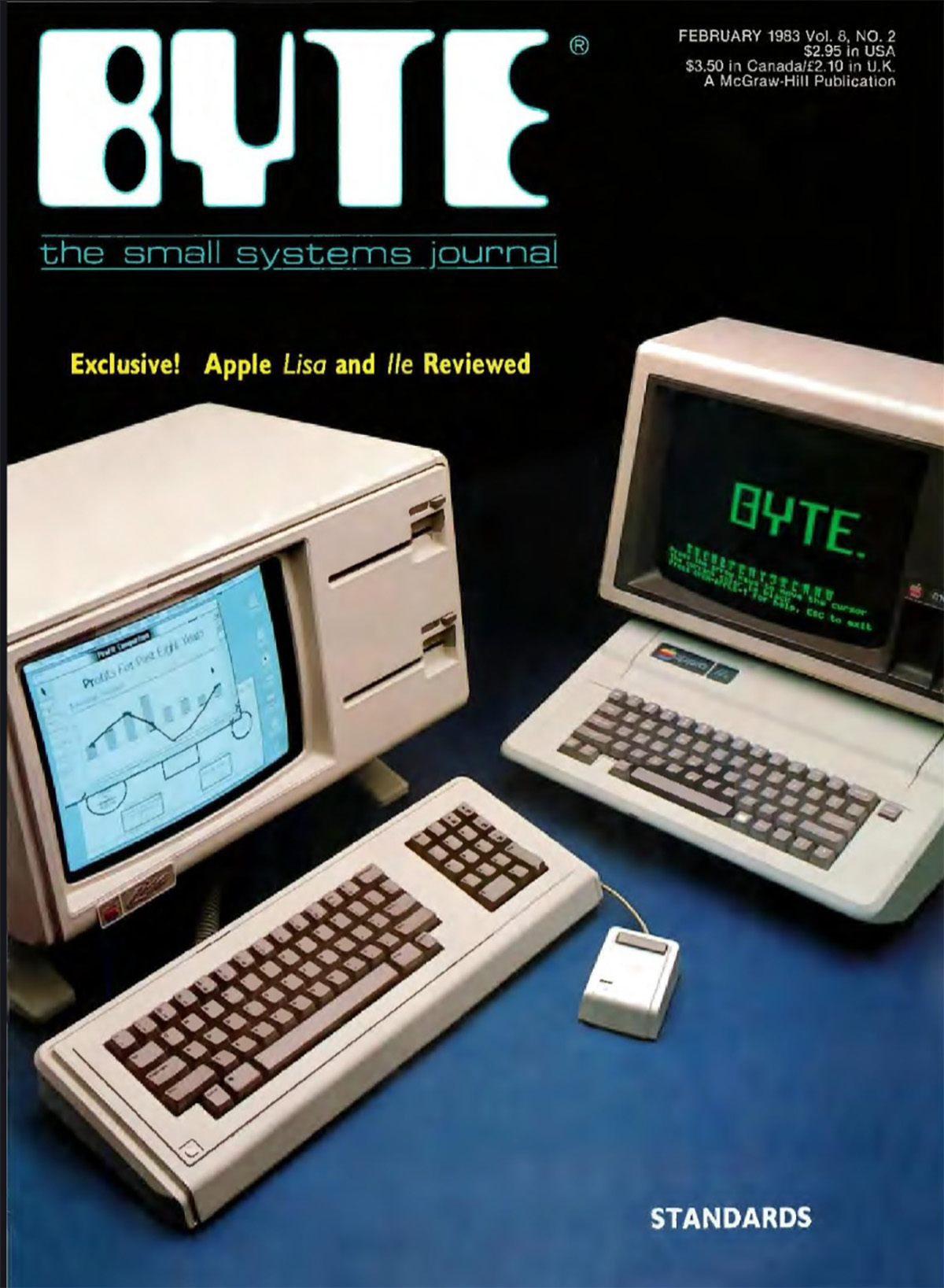
There’s also that one lonely word “STANDARDS” at the lower corner of the cover, which is sort of a theme for the issue – there’s articles about standards for the BASIC programming language, text, graphics, serial interfaces, and more. Earlier issues seem to have addressed this as well, because this issue contains this letter that caught my attention:
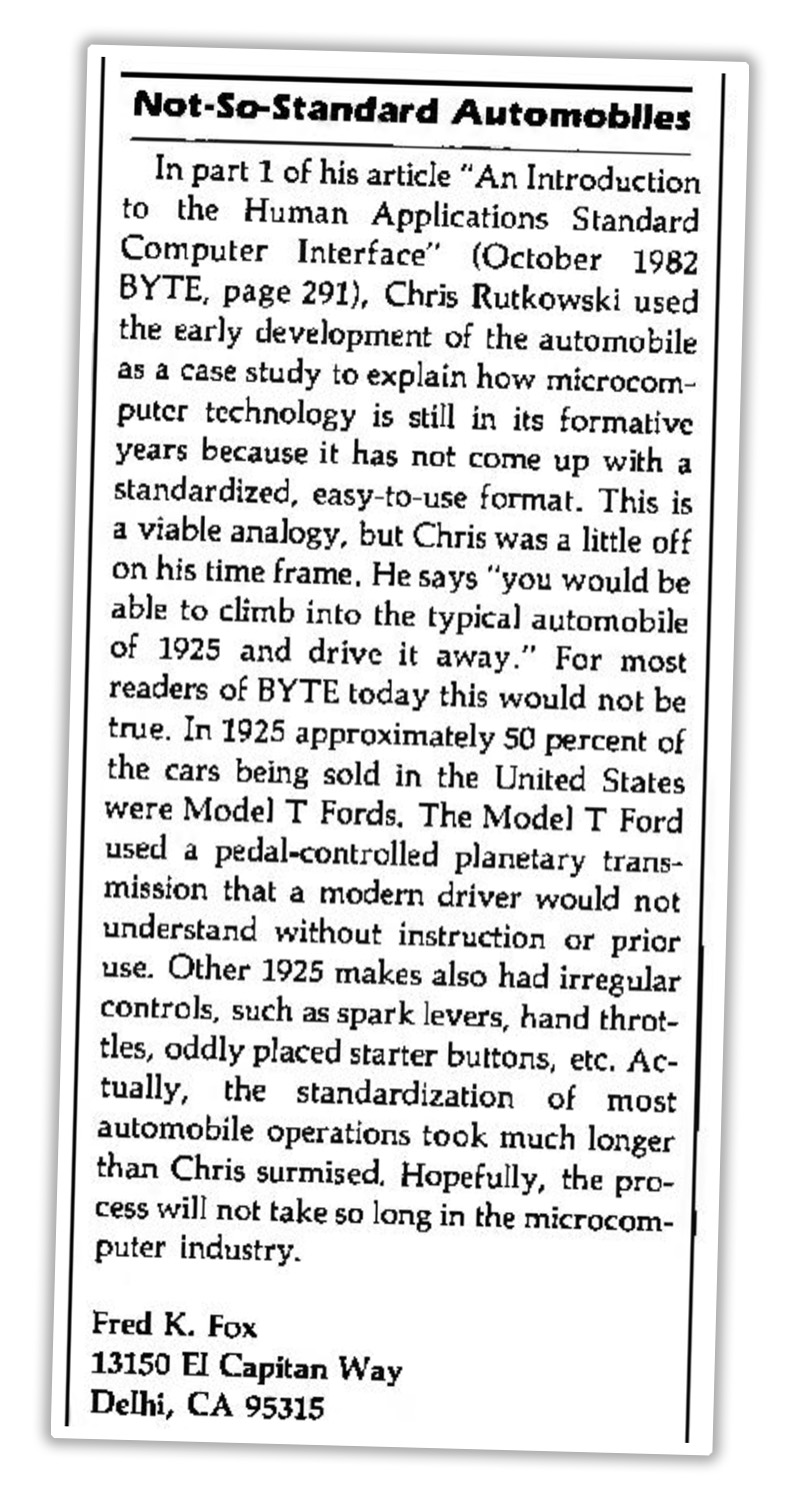
Before I get into the subject of this letter and the path of thought it led me down, it’s worth noting that Fred K. Fox is something of a legend, especially in the Studebaker collector and historical community. He’s written hundreds of articles about Studebakers and their history and arguably, the definitive book about the marque, Studebaker: The Complete Story. So this isn’t just a letter from some basement-dwelling computer geek, this is from a legitimate automotive expert.
That maybe explains why the automotive metaphor referenced in the letter stuck out to the fantastic Mr.Fox so much: it was about cars, and it was kind of wrong. And even before the internet, many of us can’t have someone be wrong, in any mass media, about cars. It seems the article Fox read was also one about standards, which stated that pretty much anyone could “climb into the typical automobile of 1925 and drive it away,” suggesting that cars had managed to become standardized with regard to basic user interface controls pretty early, and computer interfaces should follow suit.
Of course, Fox’s beef with this was a very valid one, noting that in 1925, about half of the cars on America’s roads were Ford Model Ts, which used a completely different setup of pedals and levers to operate it. The steering wheel would work as expected, at least.
Fred Fox’s point is well-taken, but it also begs the question: when did the standard pedals/shifter/steering wheel/other basic controls standards actually appear? And what was the first car to put them all together, and be something that pretty much anyone (well, anyone who can drive stick) could drive today?
Well, the first car that is generally accepted to have basic controls arranged as we understand them today is the 1916 Cadillac Type 53.
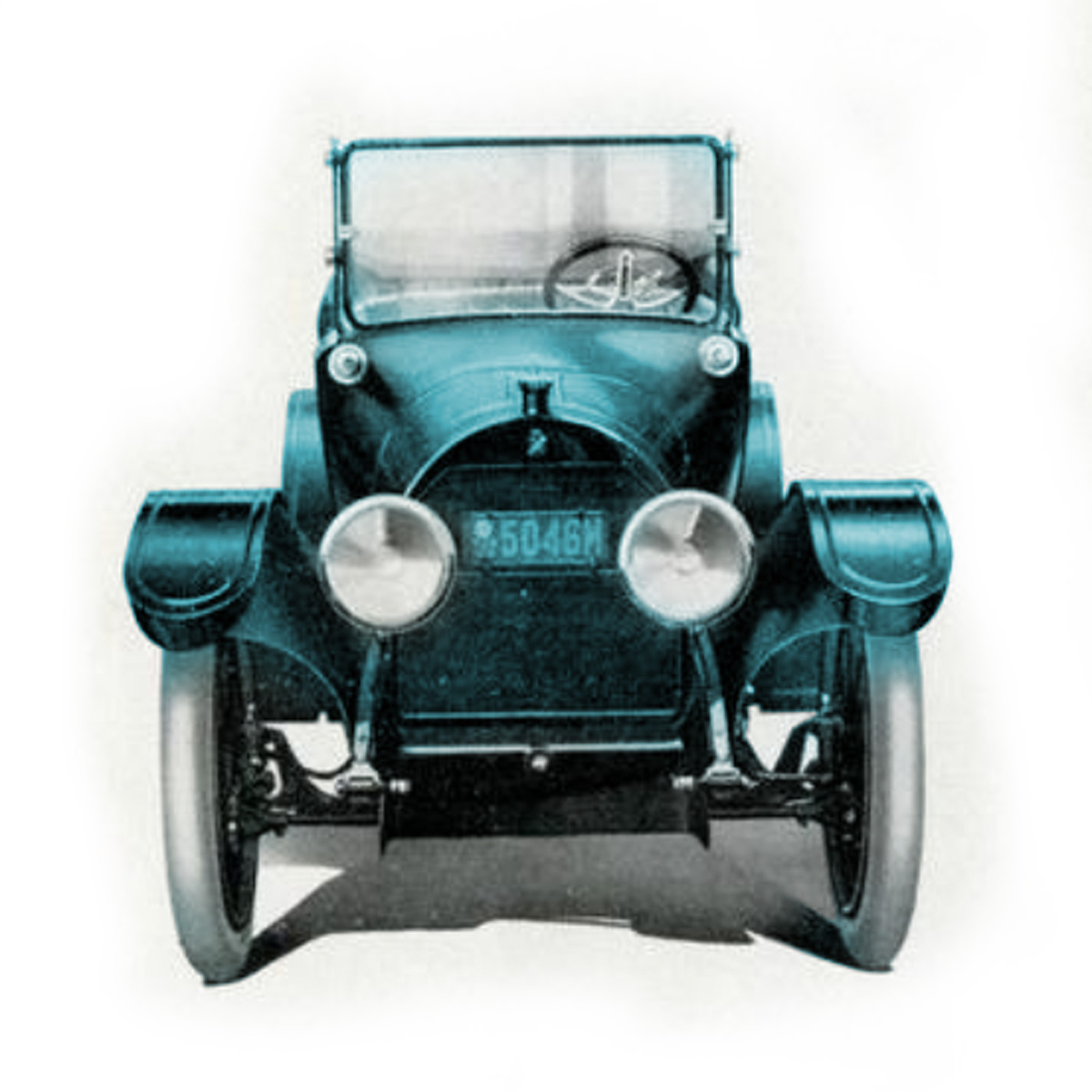
This isn’t to say that after 1916 all cars magically conformed to the standards that our muscle memories know, but that this Caddy seems to have been the first to incorporate all of the big key features in places we generally expect to still find them today: clutch, brake, and throttle pedals, in that order, a gearshift and handbrake in the middle of the floor, in front of the seats, a key-operated starter, and, of course, a steering wheel.
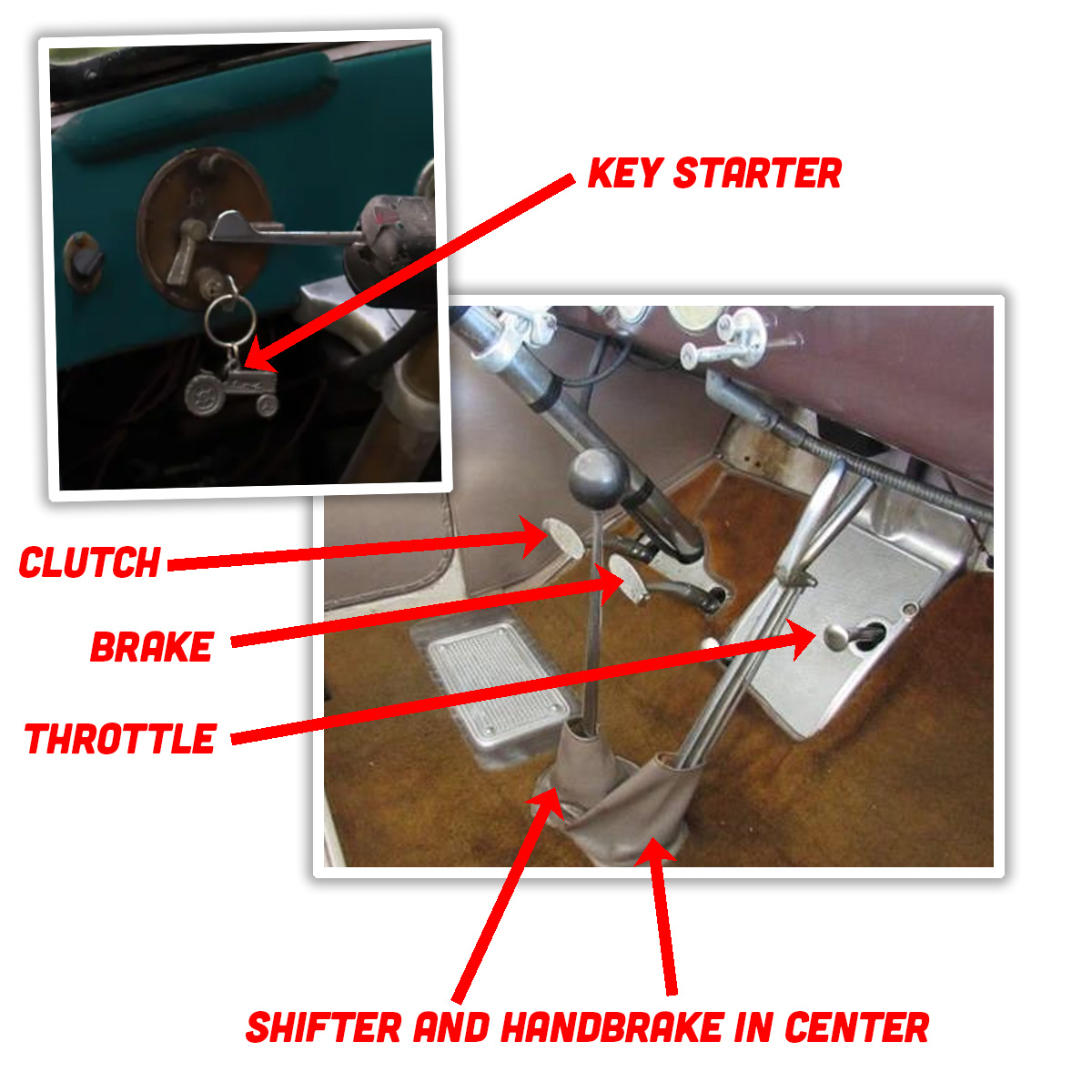
I don’t think Cadillac designed this car with the goal or expectation of setting a basic standard that would last over a century and counting; I think they just arrived at a workable combination of elements that had been being experimented with for about two or more decades at that point, more if we want to go back to the early steam era.
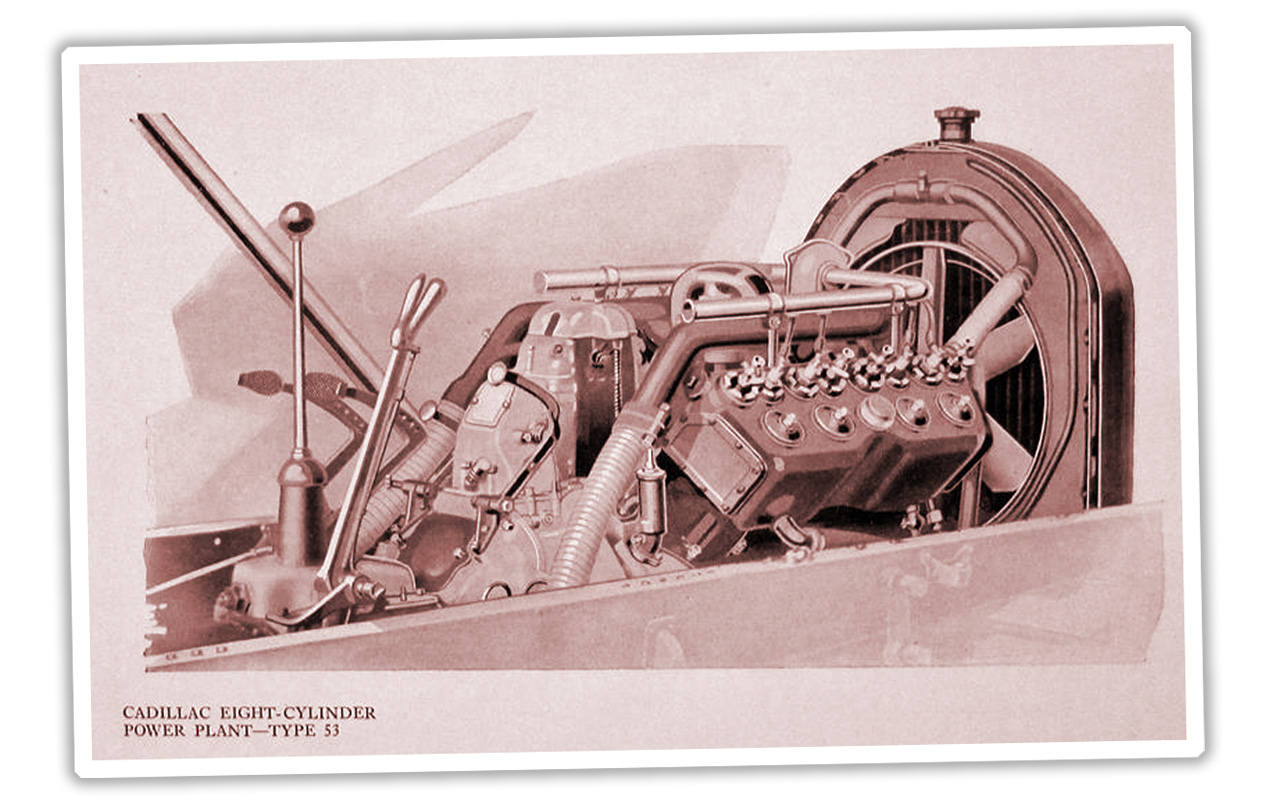
It seems to have caught on, though, and while there were still plenty of cars that did not adhere to this layout – all those Model Ts, for example, or things like the 1925 Hanomag I drove years ago that had a central gas pedal – eventually pretty much every car came around to this standard arrangement of controls.
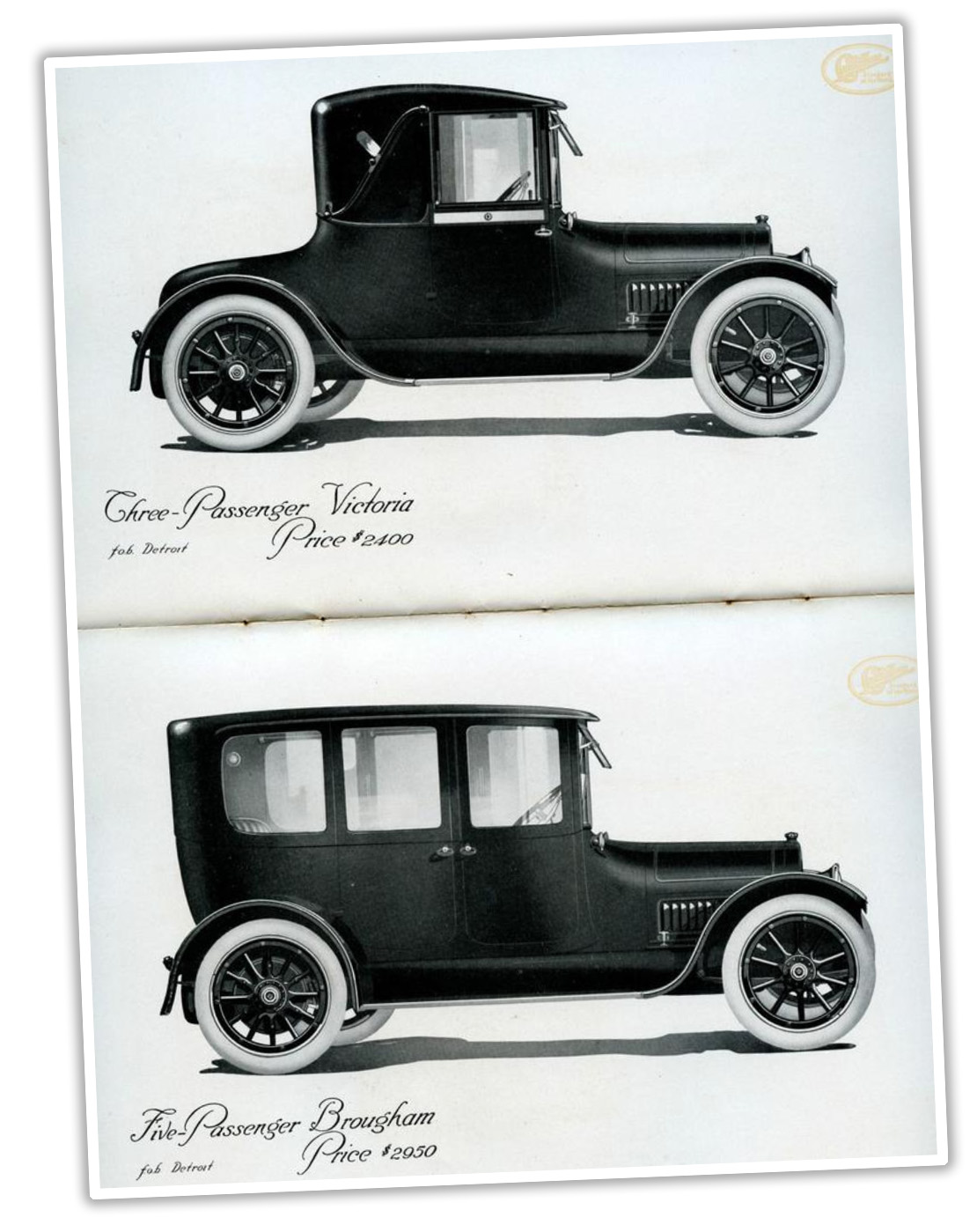
I suppose the question now is, as Fred Fox wondered, have we now arrived at a standard way to interact with computers, like we have with cars? In a way, I think we have, and it’s hinted at on the cover of the very magazine that started us down this rabbit hole. It’s that Lisa, the start of mass-market graphical interfaces on computers. It was a failure, but it’s successor, the Mac, was not, and from there we got Windows and all the other GUIs and I think the basics of that – windows, mouse, clicking, pull-down menus, and so on – are a standard on par with car pedal arrangements.
We’re also well into another standard for touch interfaces – pinching and spreading fingers to zoom in and out, scrolling, tapping, all that – so I think overall, we actually are doing okay with human interface standards. So much so that we can now be annoyed with touch screens in cars, which feels like some kind of closure of a cycle.

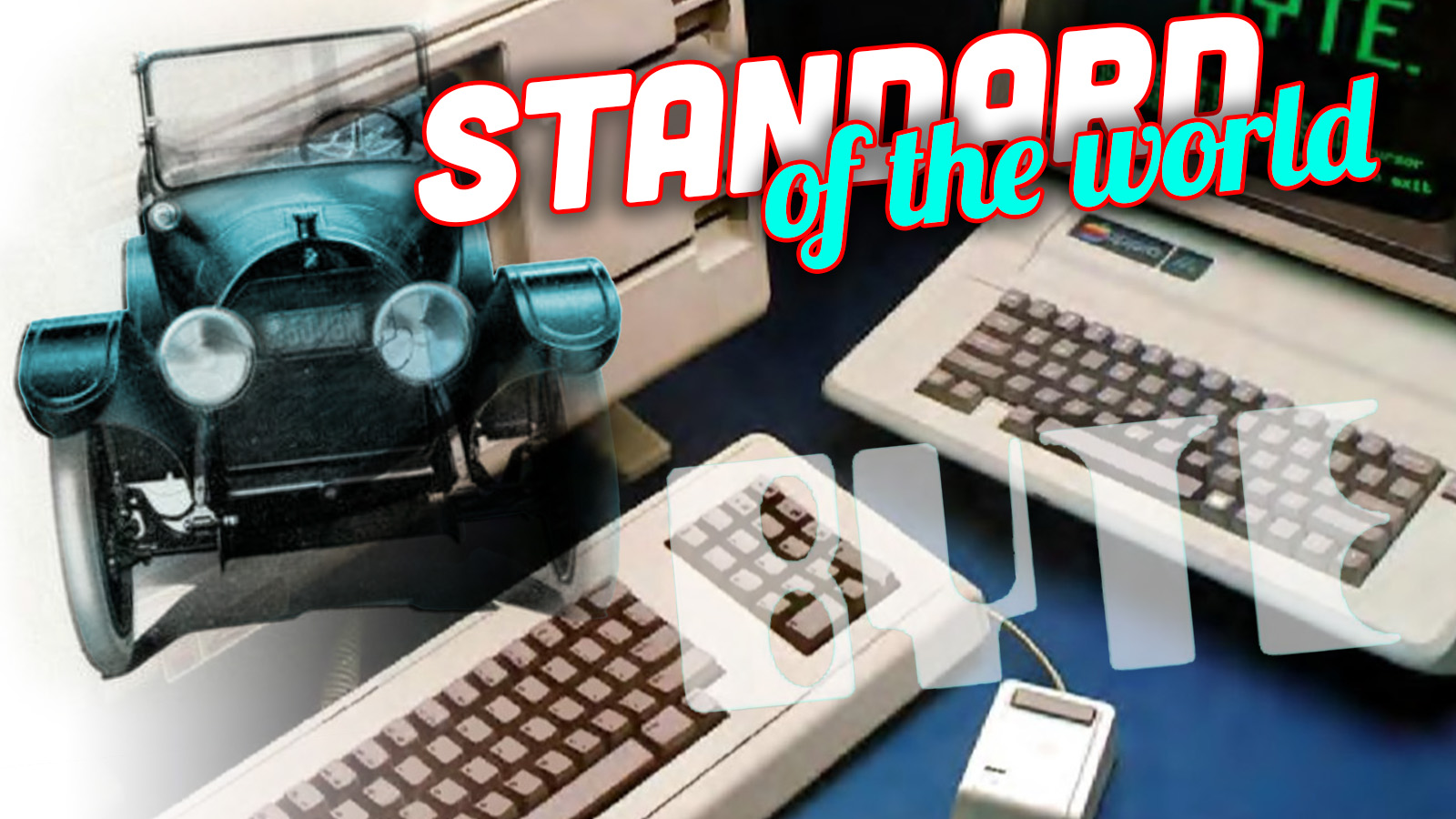




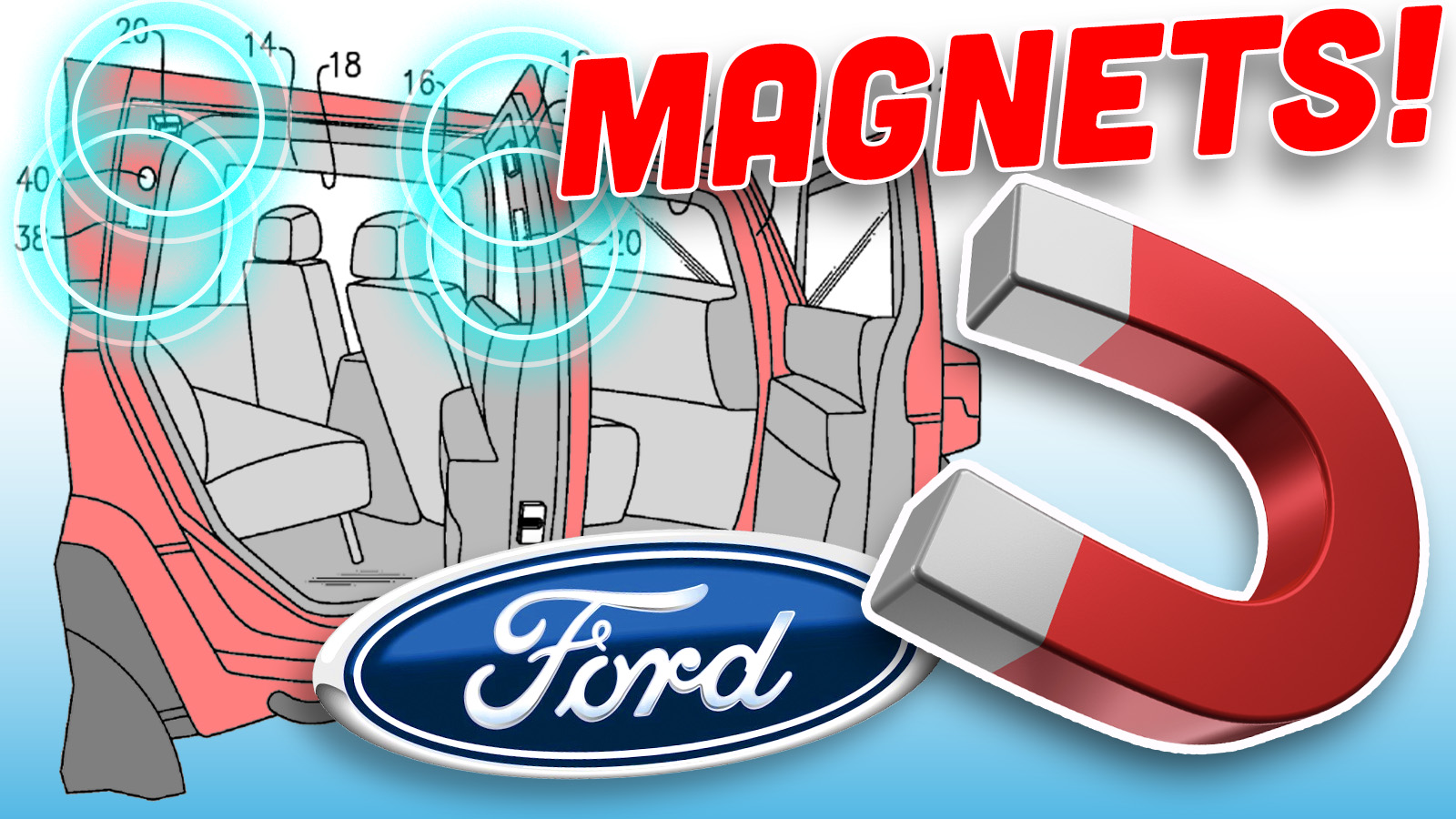

I think a good question for Torch to try to answer is – was there an era where cars were the MOST standardized in terms of controls, perhaps a few years where almost every major converged on control and interface commonality, before flying back apart into the era of touch screen insanity and gloveboxes that are opened in a menu setting somewhere.
While I have nothing but my own intuition to base this on, I feel that around 1983-1987 we hit a period where car interfaces were getting pretty close to universal, maybe with the exception being column vs. floor mounted shifters.
”its”
Thi’s
In fairness, many autocorrect systems turn “its” into “it’s” because, without context, “it’s” is just more frequent than “its,” and autocorrect is still not that smart.
In fact, I had to correct the above for exactly that reason.
ducking autocorrect
Only computer-related, so ignore if uninterested:
Of course I had an Apple //e and it was great. It was my second computer, the first being an Apple ][+ that cost me about $1,500. (plus the cost of a 5.25″ floppy drive and monitor) which I earned working my first part-time job after school and on weekends. Both Apples were eventually filled with cards: Videx Ultraterms, RGB controllers, Novation AppleCat modems, Z80 coprocessors, etc…). Using, let alone owning a computer was a novelty back then, and this was all way before the web and social media and smartphones of course. It seemed more fun back then. I miss it.
Computers are far more standardized than cars. We haven’t come much further than that Model T in terms of controls that are always the same, it’s just the steering wheel and pedals. (Most of the confusing levers on the T are automated features now) Sure, there’s some stuff that’s mostly standardized but plenty of dipshit manufactures reinvent stuff for enshitfication or just purposely being different.
Window switches are usually pretty normal, but some are in the center and there’s VW’s stupid single bank of 2 nonsense. Pull back on the stalk to flash your lights, if you have a stalk, but turning them on could be on the stalk or on the dash. Wipers could be a couple different places.
The PRNDL has been thrown completely into unintuitive chaos like other commenters said. Pretty much every other control could be anywhere, and the touchscreen UI is almost always unique garbage.
I think most high-level car nerds know that the 1916 Caddy was the earliest car that a modern driver could easily hop into and drive, but what’s the latest car that they couldn’t? Discounting trucks and tractors and novel gearshift arrangements, what’s the newest production road-going passenger car that had the basic clutch, brake, throttle and steering in a nonstandard arrangement?
You mean a manual? They still make those.
I would guess “three on the tree” is more of an impediment than a regular ole manual. I vividly remember as a child a neighbor coming over to borrow the farm truck, only to slink away when the admitted he couldn’t handle the column shifter (early 80s C-10 maybe?).
I legit find it hard to drive automatics, because I have decades of muscle memory telling my left foot to hit the clutch to change gear, whenever the engine revs climb.
In an auto, I just end up stamping on the brake pedal every time I think the car should change gear. (For the first few miles at least).
Fortunately, as a Brit, I rarely encounter automatics, although I suppose that will change with the rise of EVs
I had a co-worker from Germany call to ask how to operate his (auto trans) rental car, this was about 1996?
A few years prior to that I borrowed my father’s car, and while backing out of a parking space, I thought something was really wrong with his car.. It was me using my left foot on the not-clutch as you would to feather out of a spot slowly.. I mean there was many many things wrong with his car, it was a Mitsubishi Sapporo, but the brakes were fine.
I embarrassed the hell out of myself on my way to senior prom with that muscle memory. I took my mom’s Audi, the only automatic in our household. I found myself at a stoplight next to a friend, and of course tried to race him. Got to 30 mph, reached for the gearshift, and planted my foot firmly on what would have been the clutch in my Scirocco. We came screeching to a halt, and my date could not stop laughing. I may be the only Audi driver in the 80s to suffer from unintended DEceleration.
Maybe a Tesla with the swipe-to-shift setup they have? If you’re sitting in one of those with no instructions or experience it could definitely be confusing. You’ll find no shift lever or knob of any kind and until you hit the brake pedal you won’t even see anything on the touchscreen. Once you do hit the brakes the drive mode strip appears on the touchscreen and you then swipe up for drive, down for reverse, and tap the P for park.
Ye gods, that sounds awful.
It still has the standard ‘gas-brake-wheel’, though.
This is perfect argument about the modern controls and so true about today’s vehicles. I hate it when the manufacturers today come up with different ways of selecting gears, unlocking the doors, controlling the ventilations, and so forth that aren’t intuitive.
It’s really annoying every time I hire a vehicle from the car hire centre that I have not driven before. The centres often remove the handbooks (due to theft and sale on ebay) so I have to look up online (that is if the stupid manufacturers don’t force you to register “your” vehicle before they allow you to see the handbooks).
I would rather have the same methods of selecting gears (P-R-N-D-… in same order and direction), the visible door lock handles that don’t require you to consult the owner’s handbook to figure out, simple layout for HVAC control panels, etc.
Nice allusion to the Standard of the World ad up there. They were living up to the copy then. Standard was a much admired word for many years, really into the 70s. When my great grandfather opened his Ford agency in 1917, he named it Standard Auto Company. And the Pennsylvania Railroad was known as the Standard Railway of the World. Heady days.
My first ad client was the old Compugraphic Corporation, who made an ill-fated bet with Apple on the first, Lisa-based desktop publishing system, only to have Linotype swoop in and ink a deal for the Mac-based system. But we got the last laugh and won the market with our Mac-based products. More heady days.
My first computer was a badge engineered ’85 AT&T [Olivetti] x86 PC clone, because I liked the relatively sleek design and the green vs death yellow text on the monitor. I wonder if I could navigate the vagaries of MS DOS these days, but I like to think I could.
It all comes back pretty quickly. Like flashbacks from Nam.
I have that issue of Byte on my bookshelf. It was responsible for my coming this close to buying an Apple Lisa. Fortunately, I waited a little while and bought one of the first Macs.
One word, well, acronym:
PRNDL
It’s easy, works as a console shifter, column shifter (the way mother nature intended) & dash mounted. The muscle memory works in all 3 configs. Makes sense for ICE or EV’s.
A well evolved norm, that does not need to be re-invented!
Amen.
That order of functions/letters was mandated by the US government, USDOT Standard 102.
Can we call it basic configuration now that we have Tesla bad ideas?
Ever notice how there is no consistency between POS credit card terminals? They all have their buttons, tap pads, screen layouts/prompts, etc. in different places and layouts. I’ve even seen ones branded by the same bank in the same establishment that are different from each other. It’s incredibly stupid. It’s especially annoying when you are in a dark restaurant and try to operate one from muscle memory. All the buttons are mapped differently!
I think you could probably say the same for the payment consoles on gas pumps. Extra fun when the tiny LCD display is washed out by the sun.
It’s like cable boxes. It always feels like you get whatever deal the purchasing department scored for that month. Routers and WiFi too.
Fun standardization fact: To this day, bicycles in America and France have the front brake on the left side. While UK, Italy and most other places it’s on the right. Why? Well, there’s no universally accepted answer. There’s theories. But, overall it just sort of happened. And it’s only recently that left front is starting to take over globally. Mainly because with internal routing of cables, it’s cheaper to manufacture one standard. And most major bike manufacturers (The Big S, Trek, Cannondale) are US based.
I remember riding a very old Moto Guzzi (don’t recall the model) where the gear and the rear brake pedals where reversed. It was a head scratcher, especially since the owner didn’t warn me in advance.
Long ago I rode a friend’s Norton 850 Commando with the same setup. At least he told me.
Right side gearshift were common on British and Italian bikes until the early 70s when US regulations standardized left side shifters
Correct. It just didn’t help that the pegs were identical on both sides. If the brake had been a normal brake pedal, I might have clued in. It looked exactly like the gear selector.
I borrowed a friend’s Guzzi V7 Sport in the 80s. He had it set up with the shifter on the right, but told me he could reverse the controls easily. He just wanted it to match his Norton.
Yes, I almost learned that the hard way after moving overseas. I was on my friend’s bike, grabbed the brakes and nearly did a face plant after giving the front brakes too much force. I’d just pin that to “another thing that America does just to be different.
I’d say the standardization of most computers operating fairly similarly only really started getting a lot of traction with Windows 95.
The Mac, Amiga, Atari ST, and the C64 with GEOS had proper modern-esque GUIs by around 1987 where pretty much any modern user of any modern OS can pretty quickly pick them up and use them, but I’d say most people would have a hard time navigating pretty much anything available for IBM PCs and compatibles before Win95 (excluding dealing with drivers — using PCs sucked way more than anything else until like Win2k. At least you got most of the best games).
It just so happens that x86 PC’s were significantly more popular than anything else combined by the late 80’s, so even though GUIs were pretty standardized by, again, around 1987 or so, the majority of people wouldn’t get to experience one for another 8 years.
I will say that earlier in the 80s the computer-usage experience was also fairly standardized since everything (Other than those pesky IBMs, again) ran some variation of BASIC. So while you diffidently would have to readjust to each systems different dialect and memory locations and stuff there was a lot of interchangeable knowledge with simple, high-level programming. And since the biggest systems (The Vic20/C64 and Apple ][) both used 6502’s a lot of the basics for assembler where around the same. So, arguably, if you are highly familiar with BASIC in the modern era for some reason past the normal 10 PRINT “HELLO WORLD” things most 8-bit micros are relatively familiar.
Command line is such a joy to use. So streamlined. So efficient.
And Win 3.1 was the demarcation, not Win95.
I still contend that the best-ever version of Windows was XP Pro.
Windows 3.1 still functions differently enough that it takes a while to get used to it if you’ve been using anything more modern or from another system of the era. The concept of the desktop isn’t fully there and everything’s in sub menus and whatnot.
I always liked Windows 7. It is literally just the 98 to Vista’s 95 but eh, whatever. My experience with XP is muddled by the fact that every time I’ve used a computer with it installed it’s had so much malware as to make it barely functional.
Ok fair – I’d forgotten that there’s no real desktop in 3.1 – it’s basically just a bunch of boxes with icons in it.
XP Pro powered a lot of the Windows-based video and audio production systems I used in the early aughts, so I spent a lot of time with it. XP in homes in personal computers was a big, fat malware target.
Not loving whatever flavor we’re up to now. Same as it ever was – cumbersome, confusing, annoying to use.
MacOS has been much more streamlined for decades (since OSX debuted) and has been my preference for years now, though I use Windows and Mac machines daily.
The *nix command line and bash shell are a joy to use. Cp/m, dos, even power shell are… Not.
Powershell breaks my mind whenever I need to use it. It’s not bad, just so fundamentally different.
Supposedly, as soon as Steve Jobs saw the Xerox Alto demonstrated, he just knew immediately, from first glance, that that was how computers – all computers – were going to operate in the future, it had to be, because it made complete sense. He later said he regretted not spending more time learning and asking questions about some of the other innovations and research going on at Xerox PARC, because the GUI on the Alto consumed basically his and his team’s entire attention and that was really the only takeaway from the visit
But, the result is that the Apple Lisa is probably the oldest computer that the average user today could just jump right onto and intuitively figure out. Even the Xerox Star’s GUI, from 1981, works differently enough and is arranged differently enough that it would be somewhat incomprehensible, and that mostly copied over the ideas from the Alto that had been around since 1973, the Lisa is what really introduced the whole desktop metaphor that people are familiar with
In the early ’80s, standardization was CP/M. It did most of the real-world business stuff (word processing, spreadsheets, comms via outboard modem). Most CP/M machines would run the same programs, with varying degrees of fiddling to achieve compatibility for video & printers. But diskettes were not standardized, and it wasn’t suited for graphics (mostly text only, command-line only except you could build menu systems. Most “GUI” was character-based and came with particular software), no mouse, so never caught on with the kids. But BASIC was pretty much the same as with the toy computers. The IBM PC killed it, because “nobody ever got fired for buying IBM”.
Forgot about CP/M.
It doesn’t hurt that it was primarily stuck to Z80-based systems, and not to start the whole 8-bit era CPU debate on a car website, but in order to keep up with a 6502 or 8088 a Z80 needs a much higher clock rate and usually more memory due to its less efficient functions, which means its more expensive to have a comparable performance.
And even for business applications more advanced graphics can be pretty handy, and IBMs quickly got standardized MDA and CGA cards, along side the support of a massive company behind it so it’s really not that surprising it died off.
Fun fact, you can still buy Z80s! They’re about $8 retail. Probably a buck if you buy enough of them.
Random aside, I looked at the data sheet for the Ethernet switch chip on the openwrt reference hardware platform the other day. 2019 design. Vlans, layer 2 and 3 filtering, igmp, ipv6, etc. serious functionality, would’ve made me reasonably happy when i was doing networking 15 years ago.
in a chip they say is $1.50.
Hardware expansion was a giant mess of incompatible connectors and protocols until the IBM PC brought some sanity to onboard expansion, and USB (the protocols, and eventually the A and B form factors) and Ethernet became standards. USB-C (the form factor) brought great simplification (you can use that connector for everything) and great confusion (you can’t tell what a cable or plug can or can’t do–power? Data? Thunderbolt? How fast? How much power? Etc).
A lot of the UI paradigms Apple invented and/or licensed and/or improved have become standards, but most of their hardware interfaces and software protocols have been stubbornly nonstandard and remained that way, because think different or something? FireWire, AppleTalk, floppy super drive, file systems, one-button mice, mice without scroll wheels, and so many physical connectors I can’t remember. The world’s landfills are full of proprietary or esoteric connectors and cables only Apple used.
I LOVE reading issues of Byte at the Internet Archive, as well as InfoWorld (which seems to have been taken down). In the early 80s I was not a comp-sci kid nor a nascent programmer, but I did take computer applications classes in high school, and I was always into tech. The microprocessor revolution was such an exciting time, and I am endlessly fascinated in that part of our recent history. The future seemed wide open.
In terms of old car operation, I totally agree with Jason: Most of us have no idea what went into it. A few years ago I came across a manual for the 1915 Maxwell (later to be part of Chrysler). Here is a bit about the starting procedure:
Set the gear shift lever to Neutral
Set the spark lever (the shorter of two levers under the steering wheel) to top position
Set the throttle lever (longer lever) down about 3/4-inch on the quadrant
Place the starter plug in the switch on the heel board of the front seat
Pull the carburetor air control button part way out until the motor catches
In addition to basic operation, a 1915 car owner must know a bit about all of the systems that require maintenance. For example, there are about 30 points that require lubrication on a daily, weekly, or monthly basis. But battery maintenance is where you really get down to the nitty-gritty:
Take hydrometer readings just prior to adding water
A fully charged battery will indicate between 1.275 and 1.300 sp. gr. [specific gravity]
The battery should not be permitted to discharge lower than 1.150 sp. gr. as it causes the plates to sulphate
The specific gravity of each cell should be almost alike and not vary by more than 10 or 20 points
Source: I found this on the wonderful Old Car Brochures site, but the link is now dead, along with seemingly the entire United States section of the site.
(Guys, your site is driving me crazy, none of my post formatting seems to survive a page refresh.)
I need to check if they have copies of the Industry Standard, the late, lamented chronicle of the dot.com era. Great writing, layout, and design. And fittingly, it blew up with the boom. Their weekly hype meter was both brilliant and stunningly accurate.
My father-in-law has a T that’s been in the family for aaaaaaages and hell if I can remember which pedal does what. It’s double fun because the (hand!) brake lever is also involved.
Timing was also a learning thing, especially since it was a crank start car.
Jay Leno did a video recently where he taught one of his staff how to drive his Model T:
https://www.youtube.com/watch?v=B7mPbBxNBEo
Dad bought us an Atari 520ST in 1987 or so, cutting edge at the time. That GUI directly led to Windows, etc… years later.
Freshman year of college I had an early Pentium on a TCP/IP fiberoptic network. At the time we may have been the fastest, most connected computer network in the world.
Standards and best practices take time. It’s always interesting to see standards come in and how long they take. Thinking about GUI and standardization, apple had the education program in the 90s and early 00s. Schools primarily phased it out because the work world worked primarily on windows and the kids weren’t familiar. We seem to be repeating that to an extent with ChromeOS and IOS. Though with saas maybe it doesn’t matter as much as it once did.
They absolutely are repeating that. I teach AutoCAD on Windows computers and I spend an inordinate amount of time teaching students how Windows works. They really struggle with saving/naming files.
For what it’s worth I had more than one design/architecture professor that had some pretty extreme problems with the file cabinet metaphor. I remember one specifically that saved everything on the desktop. EVERYTHING.
Yeah, and we’re going back that way. We had a window … no pun intended … of time where most people learned and understood how to use a Windows machine. That time has passed.
I was involved in tutoring kids on computers a few times. The last time was 7 or 8 years ago after a 6 or 7 year break it was amazing to me how the last time they expected everything to have touch screen couldn’t really work a mouse all hat well and didn’t care for track pads. Generally much tougher to teach they seemed to feel it wasn’t important and that technology would almost catch up to them. As far as navigating websites they seemed a lot better from the get go. They were definitely “iPad kids”. I can only imagine now it must be 10x worse.
Oh yeah. The touch screen thing particularly. Stop getting your grubby fingerprints on my monitors you darn kids!
Which brings up another one, they all think the monitor IS the computer. They mostly have no idea what the giant black box down by their legs is for.
For sure, I used to explain form factors ,components, networking, some entry programming, and web development; to them, a real crash course. I felt if they had a real understanding from the ground up they could function better and have a good foundation for the future. It worked for the earlier kids a few of them went into computer and software engineering I think one is an AI engineer now. That last group I haven’t heard but I don’t expect that level. The was one that said something to the effect of she could use an iPad for everything and the “old computer” smell funny and give her the creeps. Anything that’s not a tablet perhaps a 2 in 1 they just didn’t want a part of.
I used to volunteer in the computer lab at my local library, and older adults, were nearly impossible to train. Common things like right clicking, drag and drop, saving files (and where the saved files “went” to, was just impenetrable to them. If you can turn on your TV with a remote, and change the channel, consider it a Win and leave everything else alone.
I’m treating ChatGPT et al as my high-water mark for understanding tech, and plan on not learning else – if I learn anything else, my brain will be so full, I’ll have forget how to ties my shoes or use a fork.
I had a stint with them too even integrated with the kids. The iPad kids and them had a lot in common. But they could use a mouse if they didn’t have bad arthritis. The not learning past a certain point argument I heard a lot then they realized they better learn at least some. I knew some old colbol and Fortran programmers that basically said that but still kept with it. One guy was in tube computing and worked with the lady who coined the terminology bug from the bugs in the basement getting in the tubes. He died a probably a decade ago in his 90s he kept up fairly well he said at one point he thought enough but kept up. My favorite are the old c++ especially mitre and open source guys that refuse whatever language of the week as they call it. For the most part they are right but rust might be their tipping point especially with cisa and mitre yelling at everyone about c++ overflows and error handing.
Rust (not David Tracy’s kind) is an interesting case. The majority of programmers of any persuasion either don’t know it or think of it as a meme language practiced by bizarre, mentally-unstable zealots. Which it is.
But it’s not just that. It does have a huge amount of potential in avoiding serious problems (as you mention), and as the old open source C guys (almost all white men aged 50 and up) die off or retire, Rust is making inroads in places where it matters, like kernels and system libraries.
I do wish Rust syntax and its practitioners weren’t so hostile, because it really does have the potential to be the new C, but the way it presents itself and its community to the world don’t do it any favours.
I’ve known enough old programers to know they don’t really die they just go off to be angry about something else somewhere else. Watching rust progression has been very amusing after watching some decently documented languages die a quick death. It seems the kernal gods have allowed it to be so it will be. It really did have a almost a script kiddie start still not very serious but seems to be the chosen replacement. Maybe rust+ will be something not so hostile. I was more in favor of go but it all but died before it went anywhere. Though I believe the Chinese might be using it for some weird risc-v library’s and kernal stuff.
People who drank the Google kool-aid (typically former Google employees who got laid off, or quit after they got rich and joined the normies in the job market) are still evangelizing go (and a bunch of tech popular inside Google that is almost always the wrong option in other companies, because Google has needs that nobody else has, except maybe Facebook). It’s … fine. But it’s not super necessary.
Probably true enough. Alot of them were on the lua hill before that. Scaling is always a major concern and selling factor for them.
Many years ago, the monitor *was* the computer. See commodore PETs, old Apples, PC/W, etc. Now tablets and smartphones have brought that back. Why should the display not be the whole thing? 🙂
I’m an ostensibly fully grown adult and on the rare occasions I read content with pictures on paper (e.g. magazine or user’s manuals), I have caught myself pinching and zooming on the page to make the images bigger. It doesn’t work. 🙁
And the big box on the desk/floor is “the modem”.
Oh, they’ve never even heard the word modem.
I was just struggling to explain what a website address was to some 6th graders.
This transcends Windows–even Mac schools have reported that younger generations just don’t know what files are. Much of the blame is on iOS and on cloud services, where files are a hidden implementation detail and finding content happens via search and browsing the content itself (e.g. photos, documents) rather than browsing filenames.
https://futurism.com/the-byte/gen-z-kids-file-systems
According to Top Gear, the car that “took Cadillac’s bright idea and showed it to the world” was the Austin Seven.
Let’s think about networking standards.. you have TCP/IP (and it’s high-revving, but not-guaranteed to deliver cousin, UDP). It wasn’t until the mid 90’s that most computers even had a NIC (Network Interface Card)… that was eventually also supplemented by various generations of Wifi. Without all of these the computers couldn’t easily talk to each other.
Next up is the OS… back in the Torch-era of computing, most computers were simple 8-bit machines and each vendor seemed to run their own OS and nothing was ever compatible between systems… even ones that used very similar chipsets. So I couldn’t take my C=64 software to my friend’s house and try to load that on their Timex Sinclair. It wasn’t until the world coalesced around Microsoft, Apple and Linux (which includes Android) that we didn’t start to see ecosystems built around their OS’s.
Next, we come down to modern API’s…. which is the bread and butter that allows folks to develop compatible software by re-using existing well-tested code. For example, if you wanted to write a spreadsheet in the 80’s, you’d have to write your own handling routines for all storage devices, and printers were no different then either. Everything is now plug and play but it wasn’t always that way. Wanna write a 3D game? There’s plenty of frameworks available to you so you don’t have to write your own physics engines… you just call the available routines you need and go on your way.
Finally, we came up with a standard way to request data and display it… Those are the web standards. Including upon which this very site depends and was written to use those standards. That’s exactly what your web browser does.
Were the nascent car and mass-market computer industries really that different? No. Both industries had to suffer with the growing pains of introducing a completely new type of product on offer, and how to make them as user-friendly as possible.
This is actually fascinating stuff, a fact I always wondered about myself.
Torch, I don’t know if you remember, but I emailed you years ago asking this question (it may have been when you were employed elsewhere):
How and when did the entire global bicycle & motorcycle industry universally decide the kickstand should be on the left? I have both from multiple decades and all of them are like this. In fact, I can’t say I’ve ever seen a bike leaning on a stand to the right.
In a world where we can’t even agree on electrical outlets, how did this happen? And how long ago?
Thread direction, perhaps? Given the standard of the right-hand thread, it would have made more sense to place the bicycle’s drivetrain on the right, where a forward pedal motion would naturally tighten the cog threaded onto the rear hub. The location of the drivetrain then dictated the location of the kickstand on the opposite side.
Most people are right-side dominant (hand, arm, leg, foot).
For such folk it’s easier to leave the left leg stationary and do whatever needs to be done – e.g. throwing a leg over a motorcycle – with the right.
Perhaps because one traditionally mounted a horse from the left side?
And why might that have been traditional…?
I think it’s for the same reason. 🙂
Exactly!
So your cavalry sword (worn on the left for righties) doesn’t get hung up on your mount, of course.
eh, I also wonder if side of the street dictated some of this. But Limey motorcycles still leaned left, even if the shifting and braking was done on the wrong sides.
On that note, the control marked above as “THROTTLE” is actually the starter button. The keyed switch turns on the ignition system but it does not activate the starter (actually a combination starter-generator). The actual throttle control is the floor button that’s much closer to the brake pedal, partially obscured by the “THROTTLE” arrow above.
I thought the throttle looked to be in an awkward position. Makes much more sense that its the starter and nub poking up behind the arrow is the throttle.
Just like the Lisa would still be unfamiliar enough to be difficult for a modern user, the Cadillac would challenge modern drivers with its separate starter button, non-synchro transmission, and manual spark and choke controls.
I still can’t manage all the swoopy/touchy things on modern computers and smartphones. Not sure I ever will, and don’t really care.
However, having put in some extensive behind-the-wheel experience with a Vintage (1924, IIRC) Bentley some two decades ago, pretty sure I can still deal with all its quirks for starting (two magneto switches — dual sparking plugs, therefore two magnetos, old chap — plus levers on steering wheel for spark advance and hand throttle, starter button) and driving (clutch, throttle in center and brake pedal for mechanical brakes on right, shift lever on right for non-synchro gearbox), and would love to have another shot at it.
Oddly enough, I had a fairly early computer — a low-memory laptop-ish piece bought at Sharper Image — and upgraded over the years to a fairly decent unit now. I learned what I had to learn but, alas, no more than that.
Vintage Bentleys are more fun. At least that one was.
We had peak standardization, but we’ve now moved away from it. Used to be, I could get into any rental car and instantly be able to drive it and operate all the strictly necessary controls with ease and confidence. Nowadays when I get into a rental car, I have to sit in the rental lot for 10-15 minutes just to learn how to operate the HVAC, entertainment system, shifter (sometimes) and etc.
I miss my GMT800. It was the last vehicle I owned wherein every control operated in a standard and obvious manner.
If you’re a GM guy, you could jump into any GM car built for probably three decades and work the wipers on the stalk by memory.
It was the fiddly cruise control that drove me nuts…
Standard for GM…which was different than Ford, and Chrysler, and the Japanese. At least the HVAC controls made more sense than Ford’s of the era, which are idiotic.
I find that renting shitty cars is way to find simplicity!
Ford used to have 2 left stalks, one for signals, one for wipers. And an utterly intuitive headlight knob.
And a little tiny button under the steering column to release the key. Yup, intuitive!
Don’t forget the “push stalk for horn”!
Dad’s Fairmont had that – the sole feature he absolutley loathed. It was fixed on our later Fox body LTD wagon and Colony Park.
He bought the Fairmont because the back windows didn’t roll down in the G-bodies. Only options were the I6, A/C, and an FM radio.
My first car was a ’78 Fairmont coupe (with the referenced “horn stalk”). A 200 inch straight six with a 3-speed manual. Payment from my uncle for painting his fence the summer before I turned 16 (1988).
I’m a few years younger. First was a ’78 LTDII coupe, followed shortly by an ’84 Fox body LTD sedan. When the 351W in the LTDII threw a rod bearing it wasn’t worth fixing due to the rust.
I grew up with Ford’s old HVAC systems. They always worked, Period. What was the issue? One lever for fan speed, one for temp. Another for climate position. A/C on or off.
The problem occurred when they went rotary; there’s no separate AC button, nor a separate recirculate button. You want AC? fine, only on your face, or defrost. Don’t want to breathe in the skanky air from the coal-rolling asshole in front of you? AC it is! IIRC they kept that for years, long after others had given up on it.
My ’98 C1500 had the same rotary system but had adopted the far more useful setup of letting you do what you want.
STD Japanese car. Headlights, turn signal on left stalk, wipers on right. Console shifter. First Corolla I ever drove (in college) I had NO IDEA where the headlights were.
American and German cars tended towards a dash knob/button for headlamps. Add in foot actuated dimmer switches and old school dash wiper knobs or GM switches…
I’m now 100% Toyota. All major controls are identical… I for one love the old cruise control dongle. Once you learn it there is never a need to look.
Do people really use cruise control?
We did, I still lament the Fuel Cap under the license plate in the center of the car. too often I fail to look for the arrow on a rental to rememember which side the fuel is filled from. though it should always be on the drivers side.
I think Ford debuted the fuel arrow. I still look for it. Yes, DS is correct.
Never mind this – did you save any of our ATARI AGE magazines? And whatever happened to those disks we had which had games, other stuff on them – I think they came with a magazine?
Or the magazines that had Basic language games in them and you had to type pages of code by hand to play the game. One typo and it probably won’t work correctly, or at all.
I remember Compute! added a checksum on each line eventually. If you typed a line and it didn’t match, you messed something up.
Signed, old C64 user (VIC-20 before that)
That’s how I learned to touch type on the keypad at very high speed. BASIC listings with hundreds of lines of machine language listed byte by byte.
100 DATA 127, 92, 48, 6, 32, 64, 102, 8
110 DATA 34, 98, 254, 128, 0, 0, 200, 8
…
2210 DATA 127, 255, 0
Some things are so easy to search for, that asking someone else to do it for you is akin to deliberately dropping an object on the floor, and demanding that someone else picks it up.
https://atariage.com/magazines/index.php
Isn’t that what younger brothers are for?
Henry Ford: The gear shift pedal needs to be on the floor and the spark advance on the steering wheel, with a hand-brake and a foot brake!
William Murphy (Apparently there’s no Steve Cadillac): Gas/Brake/Clutch on the floor and we’re done, fellas.
Andre Citroen: Let go with a brake bladder and stick some controls in the ceiling. By the way, we should have a wheel lift itself.
Dodge Bros: Who the hell let him in here?
Don’t forget the throttle lever on the other side of the T wheel…
Bravo. I actually get that yoke.
IIRC, the early Dodges inverted the usual floor-shift pattern – reverse was left-back and first was left-forward. Which could be awkward at a stoplight. So the Bros can go a little easy on Andre.